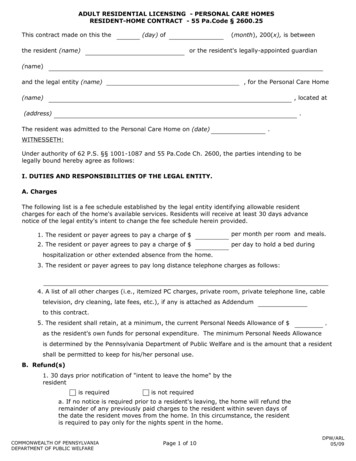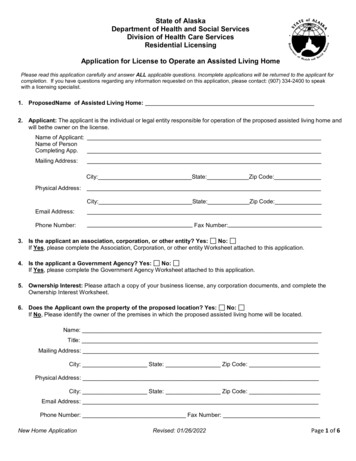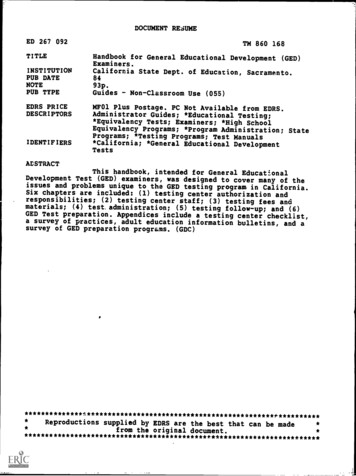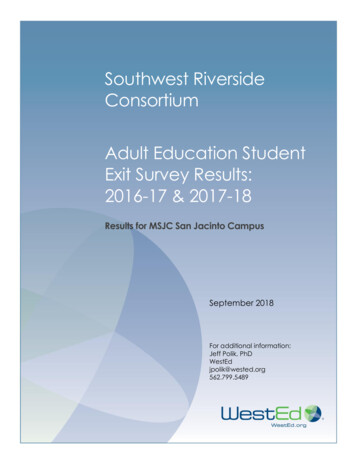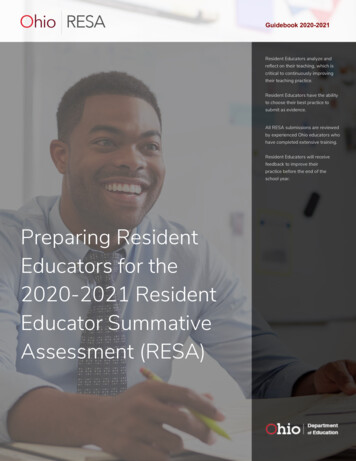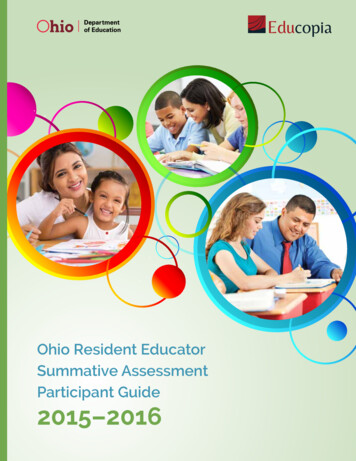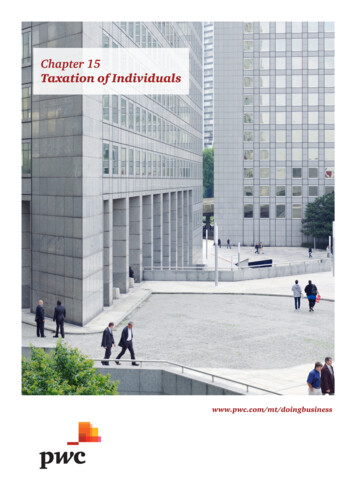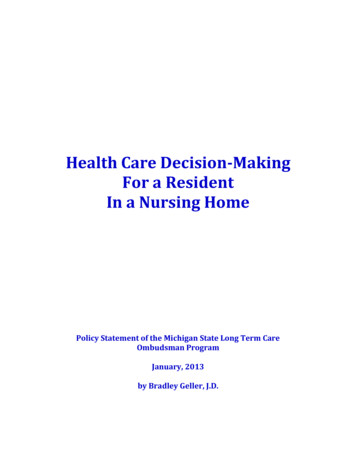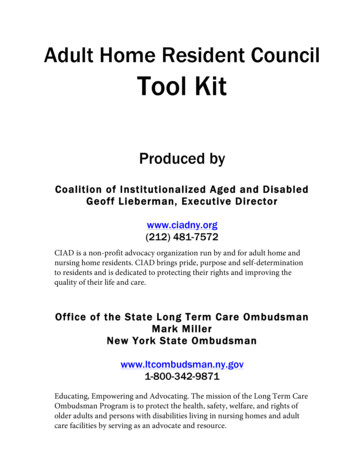
Transcription
Adult Home Resident CouncilTool KitProduced byCoalition of Institutionalized Aged and DisabledGeoff Lieberman, Executive Directorwww.ciadny.org(212) 481-7572CIAD is a non-profit advocacy organization run by and for adult home andnursing home residents. CIAD brings pride, purpose and self-determinationto residents and is dedicated to protecting their rights and improving thequality of their life and care.Office of the State Long Term Care OmbudsmanMark MillerNew York State ating, Empowering and Advocating. The mission of the Long Term CareOmbudsman Program is to protect the health, safety, welfare, and rights ofolder adults and persons with disabilities living in nursing homes and adultcare facilities by serving as an advocate and resource.
This Tool Kit is published as part of theAdult Home Resident Council Training ProjectBy the Coalition of Institutionalized Aged and Disabledand the New York State Office of Long Term Care OmbudsmanCopies are available by downloading from:Coalition of Institutionalized Aged and Disabled (ClAD)www.ciadny.organdNYS Long Term Care Ombudsman Programwww.ltcombudsman.ny.govFunding provided by The NYS Attorney GeneralSpecial thanks to all who contributed their help and expertise:Resident Council Officers: Norman Bloomfield, Margueritte Cogan, Coco Cox,Stuart Goldberg, Irene Kaplan, Bob Larkin, Gary Levin, Barbara Murray, TonyRizzo, Robert Rosenberg, Ilona Spiegel, Mike Staines, Calvin Parsons Taylor,Joan Tell, Derek White, Margueritte Wilkins, Woody Wilson, Alex Woods,Steven YaariLTCOP: Becky Bradley (Broome/Delaware), Harriet Bunker (Hamilton/Warren)Amy Gehrig (Clinton/Essex), Michael Fober (Rockland), Melanie Keem(Erie/Cattaraugus), Jeff Parker (Herkimer/Oneida), Gwen Starke (Greene),Ellen Ott, Katie Hammond (Columbia/Dutchess/Orange/Sullivan/Ulster),Cindy Stout (Cortland), Joan Burke, Ken Meyer (Suffolk), Paula Goolcharan,Nazmoon Prithwipail, Joanne Delaney, Charles Ephraim,Charles Gourgey (NYC Ombudsman Program)NYS Department of Health: Mary Hart, Bobbie BarringtonAdult Home Staff: Maxine Cardwell, Mary TwohillCIAD Adult Home Organizer: JK CanepaBy Jennifer StearnsPublication Date: September 2014Adult Home Resident Council Tool-Kit 2014 i
ii Adult Home Resident Council Tool-Kit 2014
Table of ContentsIntroduction .1Using The Resident Council Tool Kit .3Importance of Resident Councils .5Resident Council Rights and Regulations .9Role of the Ombudsman in the Resident Council . 11COUNCIL ORGANIZATIONDifferent Kinds of Resident Councils . 15How to Start, or Rebuild, a Resident Council . 19Resident Council Bylaws and Council Structure . 23BASIC Resident Council Bylaws – GUIDE . 25BASIC Resident Council Bylaws – WORKSHEET.27COMPREHENSIVE Resident Council Bylaws - GUIDE . 29COMPREHENSIVE Resident Council Bylaws - WORKSHEET. 35How to Run a Free and Fair Election . 43The Role of the Council President . 45The Role of the Vice President .47The Role of the Secretary . 49Role of the Staff Advisor in the Resident Council .51Ways to Provide Support Without Taking Charge . 55CONDUCTING MEETINGSThe Role of the Council Leader During Meetings .57Addressing Complaints and Arriving at a Decision . 59Meeting Agenda Guide .61Why Taking Minutes is Important . 63TIP SHEET: How to Handle the Minutes . 67Resident Council Minutes . 69COUNCIL COMMITTEES, ACTIVITIES AND PROJECTSCouncil Committees .71Hospitality Committees and HIPAA privacy rules. 73Food Committees . 75Council Activities and Projects . 79The EQUAL Grant – a Unique Council Opportunity . 83Advocacy and Coalition Building.87SOLVING COUNCIL PROBLEMSHow to Increase Attendance at Meetings . 89Adult Home Resident Council Tool-Kit 2014 iii
How to Encourage Participation at Meetings .91How to Counter Residents’ Fears. 95How to Handle Disruptions During the Meeting . 99Strategies for Improving a Dysfunctional Council . 103SOLVING PROBLEMS IN THE FACILITYThe Resident Council in the Inspection Process . 107How to Make a Complaint . 111TIP SHEET: How to Use the Hot Line . 115APPENDICES / RESOURCESResident Council Sample Documents Resident Council ByLaws The Council Bylaws Resident Council Minutes Resident Council Meeting Minutes Application for NYS Department of Health - Enhancing the Quality of AdultLiving (EQUAL) Program - Expenditure Plan Resident Council Approval of EQUAL Funds Spending Plan Sample EQUAL Program Expenditure Plan EQUAL: New York State Grant Program (brochure)Food Committee Sample Documents The Constitution of the Food Committee Food Committee - Minutes for July 13 Meeting Resident Food Committee Survey on Food Sanitation and Safety Food Committee Breakfast Survey Breakfast Survey (Bread and Cereal) Food Committee Resident Survey Food Committee Meal Monitoring Project How to Organize a Food Committee in Your Home (brochure)Leadership Training Sample Documents Leadership Training Agenda Leadership Development - Skills & Tasks Negotiation and Conflict Resolution Active Listening Techniques Roadblocks to Communication Responding to Resistance from Others Negotiation Role Play 1 Negotiation Role Play 2 Negotiation Role Play 3 Negotiation Role Play 4Resources County Ombudsman Contacts Adult Home Leadership Council - Family Service League Long Term CareOmbudsman Program (brochure)iv Adult Home Resident Council Tool-Kit 2014
IntroductionBefore developing this tool kit, CIAD andthe NYS Long Term Care Ombudsman Programconducted a survey of residents, ombudsmen andfacility staff. The results show that most NYS adulthomes we surveyed have resident councils, thatresident council leaders are generally elected, andthat many councils are nominally resident-run.“These coalitions bringtogether resident activistsfrom different facilities toshare information”Our follow-up interviews and visits to residentcouncils showed us the wide range of forms theytake. In some well-organized and impressively ledcouncils, the leaders pressed us for copies of sample bylaws and other resources even aswe were drafting them. We have tried to accommodate them by providing comprehensiveversions of these documents. For the many less formally structured councils, we haveprovided simpler, more basic versions of the documents.A common problem for councils in homes large and small is the scarcity of committedleadership, due in part to residents’ mental and physical disabilities. Even when two or threeactivist residents team up to run a good council, they are isolated within the home — hardput to find others with enough energy or interest to help.An antidote to such isolation is the creation of regional coalitions of resident leaders, suchas CIAD’s Policy Committee in New York City, and the Adult Home Leadership Councilon Long Island. These coalitions bring together resident activists from different facilities toshare information, offer each other moral support, and work together for policy reformsthat benefit everybody. It is our hope that this project will inspire the formation of moreregional coalitions of resident council leaders.Adult Home Resident Council Tool-Kit 2014 1
2 Adult Home Resident Council Tool-Kit 2014
Using The Resident Council Tool KitThis resource is designed for use by ombudsmen, staff advisors, and residents of adultcare facilities. It is written with the understanding that every resident council is different;there is no “right” way to do things.We encourage you to pick and choose from these pages what you want to use. Work sheets and tip sheets can be taken out, copied, and distributed. Information on local resources can be added, as well as other materials you’vedeveloped or identified. It is a collection that we encourage you to add to. Examples are included of bylaws, minutes and other documents used by existingresident councils and food committees. Fact sheets are provided on laws and regulations relevant to council work, and onother matters of interest, such as EQUAL grants. Leadership development materials are also included for council members who wantto improve their skills.This tool kit is based on the firsthand experience of ombudsmen and advocates workingin adult care facilities, and reflects extensive interviews with resident council officers. Ourhope is that members and advisors of all kinds of councils will find something of value here.Adult Home Resident Council Tool-Kit 2014 3
4 Adult Home Resident Council Tool-Kit 2014
Importance of Resident CouncilsResident councils may be large or small, formal orinformal, completely self-governing or largely dependenton staff—whatever form they take, they offer a uniquespace for residents to come together and discuss theirown concerns.“Resident councilsare meant to givepeople a voice intheir facilities”For residents, council meetings can be a forum fordebate, an opportunity for fellowship, an interesting and challenging activity, and a sourceof information and resources.Under law, resident councils are meant to give people a voice in their facilities, andmanagement an established channel to hear what residents have to say. State law supportsthis function, saying councils must be allowed to “report all problems, issues and suggestionsdiscussed by residents” to management, and management must respond. For this reason,council meetings are sometimes seen by management as a “license to complain.”In practice, active resident councils prove to be an asset to management, rather thana liability. Residents and staff generally want the same thing—a well-functioning facilitywhere people get along. Independent resident councils can help achieve this goal.Such councils attract leaders who are often among the most connected and respectedresidents in the home. They can help resolve problems between residents, and betweenresidents and staff. In many homes, council leaders have joined management in urgingfellow residents to refrain from littering, damaging furniture or smoking in their rooms.Over time, administrators and council officers can develop an ongoing dialogue and aconstructive working relationship.The opposite holds true as well. Homes that bypass democratic procedures and set upco-opted councils exacerbate conflict and discontent among the residents. Without anindependent council, residents lose their voice in the facility. And without an independentcouncil, management loses a valuable “early warning system” about problems in the home—as well as a valuable partner in solving them.For residents, the benefits of council membership go far beyond problem solving. Inan institutional setting, running a resident council is often the only officially sanctionedactivity residents can organize and manage themselves, to the extent of their ability. Thisopportunity to exercise autonomy delivers a huge dividend in mental health and well-being.Residents can take on different roles within the council and within the home, and continueto learn and grow.In delivering quality of care, it is in every facility’s interest to fully support a residentcouncil that functions as democratically, and as independently, as possible.Adult Home Resident Council Tool-Kit 2014 5
6 Adult Home Resident Council Tool-Kit 2014
Quote from Adult Home Administrator, Maxine Cardwell:From an interview recorded by the CIAD Media Team in July, 2007“I believe if we have a strong resident council, it helps the whole facility—because not only do we have cooperation from the staff, we havecooperation from the residents as well. They want to make things work,and they help me because they are here 24 hours a day, and they see whatgoes on.”Quote from former Staff Advisor, Mary Twohill:From an interview recorded by the CIAD Media Team in July, 2007“The resident council lets people have an open forum where they can voicetheir opinions, their problems and their wants, and not be intimidated—but be listened to and heard. There’s a formal process to it. It’s not just oneperson at a time having a problem and going to the administrator. It’s adefinite, formal process. Your problem is presented at the meeting, it isdiscussed by the board, and the board members bring it to the administrator.The administrator must respond in one way or another, and that responseis carried back through the board to the council, and everyone hears theanswer. It helps staff in a hundred different ways because when staff canhear about a problem, and be made aware of a problem, then they can dealwith the problem and it makes their job easier.”Quote from Resident Council President, Woody Wilson:“Sooner or later management figures out that it’s to their advantage to havea good resident council. They can go to the council and explain why theycan’t do something because it’s against the regulations, or they don’t havethe money. And even if you don’t get the problem resolved, at least you havea way to talk about it. Some of the things that worry residents — they canbe changed. If the administrator knows that these things are unpleasantor irritating to residents, and they can be changed without costing anymoney or breaking any state regulations, then often the administrator willchange them. But it has to be brought to somebody’s attention first.”Adult Home Resident Council Tool-Kit 2014 7
8 Adult Home Resident Council Tool-Kit 2014
Resident Council Rights and RegulationsNew York State law requires all licensed adult care facilities to have a resident council“chaired and directed by the residents.” Each facility must assist in the formation of a counciland facilitate its meetings.These responsibilities are laid out in Title 18 of the New York Compilation of Rules andRegulations (NYCRR).According to NYCRR Title 18: Section 487.5:(b) Resident organizations.(1) The operator shall encourage and assist residents to organize and maintaincommittees, councils, or such other self-governing body as the residentsmay choose.(2) The operator shall:(i) assure that the residents’ organization:(a) meets as often as the membership deems necessary;(b) is chaired and directed by the residents; and(c) may meet with any member of the supervisory staff, provided thatreasonable notice of the request is given to such staff;(ii) appoint a staff person to act as an advisor to the residents’ organization,who shall serve as a liaison between the organization and administrationto report all problems, issues and suggestions discussed by the residentswhich require administrative action; and(iii) assure that any complaints, problems or issues reported by the residents’organization to the designated staff person or administration beaddressed, and that a written report addressing the problems, issuesor suggestions be sent to the organization.In practice, these NYCRR regulations have been interpreted by the NYS Department ofHealth to require that facilities: provide a space for the council to meet; allow the council to meet regularly at a time convenient to most residents;allow special council meetings when requested by residents; allow residents to meet without staff present, if they so desire; make staff available when requested; provide written responses to questions submitted in the minutes.Adult Home Resident Council Tool-Kit 2014 9
According to Mary Hart,formerly of theNYS Department of Health(Mary Hart, former Director, Bureau of AdultCare Facility Quality and Surveillance, from a2008 interview with the CIAD Media Team):“We expect that the operator,administrator, allows theresident council to functionon its own, and allows it toinvite staff people to take partwhen they are wanted. Wenormally at DOH don’t runup against any issue unlessthere are complaints — thatthere’s interference with anelection, or council meetingsare cancelled with no notice.Then we will come in and say— ‘You have to encourage theresident council to functionand to respond to their issues.’We have cited facilities foractively either discouragingcouncil functioning or notassisting residents in gettingone started.”The NYS Department of Health is chargedwith providing oversight and enforcement ofthe above regulations. Therefore when a facilityrepeatedly undermines residents’ attemptsto form an independent council, residentsmay file a complaint through the ComplaintHot Line of the NYS Department of Health.Residents may also contact the OmbudsmanProgram County Coordinator in their area,or their own facility ombudsman, if they haveone. (See How to File a Complaint)As with all complaints, those regardingresident councils must be clear violations ofthe law as written. DOH is able to take actionwhen residents can show that their requeststo hold council meetings and elections havebeen denied or cancelled; that a meetingspace has been requested, but not provided;or that residents have asked to direct theirown meetings, but have been forced to acceptdirection by staff. These are concrete violationsthat, if substantiated with documentation,can be investigated by DOH, and addressed.More often, resident councils areundermined in ways that are subtle, hard todocument, and difficult for DOH to address.For example, management may accept, oractively support, a clique of council officersthat rejects democratic procedures, does notrepresent or acts against residents’ interests.In this case, it may be impossible for DOHto choose between one group of residents andanother. The above regulation simply statesthat resident councils must be “chaired anddirected by residents;” it does not stipulatehow these leaders are to be chosen.Even if DOH cannot take action, however,resident leaders in facilities with co-optedcouncils can still act in their own behalf. Ina number of cases, residents have succeededin taking back compromised councils, andrestoring their independence. (See Strategiesfor Improving a Dysfunctional Council)10 Adult Home Resident Council Tool-Kit 2014
Role of the Ombudsman in the Resident CouncilResource/Advisor/Trainer/OrganizerBuilding a good working relationship withthe resident council can be an important, andsatisfying, part of an ombudsman’s role. No federalor New York State law defines this particularfunction. The only law pertaining to ombudsmenattending council meetings states simply “visitorsshall be allowed to attend meetings at the group’sinvitation.”The Ombudsman Program Training andResource Manual stresses the importance ofsupporting resident councils, and suggests that anombudsman might: “strengthen the functioning of the council,if appropriate; provide information and education on avariety of topics; meet with the council regarding problemswithin the facility.” Attend council meetingsregularly, upon invitation Establish and reinforcethe principles of goodgovernment Act as mediator Provide information andguidance Mediate between the counciland the administrator Offer leadership developmentAn ombudsman’s relationship to a council willbe shaped both by the residents who make it up, and by the staff advisor, if there is one. Incouncils with active staff advisors, ombudsmen may find ways to assist the advisor, as wellas the residents. In councils with no staff advisor present, ombudsmen may play a moreactive role, helping at times to structure and guide the council, and mediate between it andthe administrator.Here are tips and examples from ombudsmen who assist resident councils inNew York State adult homes: Attend council meetings regularly, upon invitationRegular attendance helps you build a relationship with council members, and developappropriate ways to provide support. Over time, your consistent participation willshow members that you can be trusted to remain neutral, both between residents,and between residents and management. Residents need your support, and will beginto seek it when they trust that your primary goal is to strengthen the council. It isimportant to:–Ask for an invitation before attending;–Avoid taking a seat in front of the group, and acting as if you are a council officer;–Observe the rules of conduct, along with everybody else.Adult Home Resident Council Tool-Kit 2014 11
Establish and reinforce the principles of good governmentWhen one resident seems right, and another wrong, it is tempting to take sides.Instead of doing so, emphasize principles that help everyone—fair procedures,orderly meetings, and respectful conduct.Example: “The council in my facility has no staff advisor present. When I first startedattending council meetings as an ombudsman, every meeting would degenerate intoshouting matches between the president and several residents who opposed him.After a few such meetings, I asked the president for permission to try an intervention.At the next meeting, he gave me the floor and I went to the front of the room witha poster board. I suggested that residents come up with a code of behavior for theirmeetings. They agreed on a set of rules, which we wrote down. After several meetings,the reminder wasn’t necessary—members themselves kept order.” Act as mediatorDuring council meetings, an ombudsman can sometimes serve as a safety valve—aneutral referee who can, when necessary, nudge a meeting back on track, deflect apersonal attack, or suggest a more balanced approach. These instances should be rare,however. Only when a meeting seems at an impasse, should you offer a temporarydose of leadership—and only with residents’ explicit or implicit permission.Example: “On the day after the EQUAL Grant Application was issued, theadministrator cornered the resident council president and pressured him into signingthe grant application then and there. (See The EQUAL Grant). Feeling intimidated,the president signed the application, thereby bypassing the council, and deprivingthe other residents of a chance to vote on what they wanted to spend the money on.At the next council meeting, several residents vented their anger at the president in away that became hurtful. I raised my hand to calm the waters, suggesting that peopleput themselves in the president’s shoes. The administrator had confronted him firstthing in the morning, when he was alone and unprepared, and had pressed him tosign the document immediately. Rather than attacking the president, I suggestedthat residents discuss how to deal with the grant the next time it came around. Myintervention stopped the blame game, and got folks to adopt a more constructivetone.” Provide information and guidanceAs an ombudsman with links to adult home and long term care advocacy groups,you can serve as a valuable source of information for council members, who can thenpass on the information to other residents.Example: “When I look over my notes for a year’s worth of council meetings, I seethat I provided information about all kinds of residents’ rights issues, as well as about12 Adult Home Resident Council Tool-Kit 2014
the home’s obligations—what it has to provide in the way of heat and air conditioning,case management, transportation, laundry. And I constantly provided updates on thestatus of a supported housing settlement that may greatly affect residents’ lives.” Handle complaintsCouncil meetings are a good way for an ombudsman to keep an ear to the ground.When problems develop in the home, you often hear about them first at a councilmeeting. If there is a credible complaint, you can take this opportunity to ask residentswhat they want to do about it. At times, they may just want to write a question intothe minutes and see how the administrator responds. At other times, they may wantto file a formal complaint. As an ombudsman, it is easier to originate a complaint inthe resident council as a group, than persuade an individual resident to take a stand.Example: “At one point, the home lost control of the laundry situation. Somethingbroke down, and laundry started piling up. After several weeks of having theirclothes disappear into the laundry room and not come back, residents were fedup. At the council meeting, a dozen residents signed my ombudsman complaintform, and a resident and I both called the Complaint Hot Line. Then I spoke to theadministrator about the problem. The next day, the laundry was taken care of at anoutside laundromat.” Mediate between the council and the administratorOmbudsmen can function as go-betweens in both directions — between the counciland the administrator, and between the administrator and the council.Example: “Usually I convey complaints from the resident council to the administrator,but one day the situation was reversed. The administrator said there was an exaggeratedclaim in the minutes for the last meeting—that hot water in the facility had beenoff for several days. She was upset, but didn’t want to approach the council directlybecause she knew staff was not welcome. I presented the administrator’s complaintto council members, and they agreed to discuss the issue with her. She joined themeeting and laid out her version of events. Residents compared notes and concludedshe was right—the hot water had only been turned off for half a day. The administratorrequested that the previous minutes be changed. The council president said he wasuncomfortable changing the official minutes of a past meeting. I suggested adding acorrection to the minutes in the form of a footnote, initialed by the president. Thiscompromise was accepted.”Adult Home Resident Council Tool-Kit 2014 13
Offer leadership developmentResident leaders can benefit greatly from leadership development exercises, such asthose included in this tool kit. These tried-and-true exercises have been used by CIADorganizers to help council leaders assess their own leadership styles, learn activelistening skills, and practice conflict resolution and problem solving techniques.Example: “When I attend council meetings, I occasionally give the president feedbackabout how he conducts the meetings. He used to curse a lot during meetings, and Ispoke to him about it afterwards. I said that behavior is inappropriate, and there arepeople there who might be offended. He also has a tendency to belabor a point fromtime to time—just goes on and on. If I can, I try to catch his eye, and motion him onto the next topic—but unobtrusively. He has thanked me after the meeting. I pointedout that once you lose people’s attention, it’s hard to get it back.”14 Adult Home Resident Council Tool-Kit 2014
Different Kinds of Resident CouncilsResident councils vary greatly from one home to another, depending on the size of thefacility, and the number of actively interested residents. The right kind of council for anyparticular home is the one that empowers the most residents to participate and have a voicein the governance of the facility. In small homes, or homes with low resident participation:– Informal family-type meetings may work best.– Agendas may consist of topics called out by those present.– Chairperson and secretary roles may be filled by volunteers, or on a rotating basis.– Time can be taken to canvas everyone’s opinions one by one.– Most decisions may be arrived at by consensus.– Minutes and by-laws may be simplified.– A recognized monitor or referee may help guide the discussion. In homes where residents are physically frail:– The staff advisor plays a more active role.– Meetings work better in smaller groups—such as meetings on each floor.– More one-on-o
Funding provided by Th e NYS Attorney General Special thanks to all who contributed their help and expertise: . Mary Hart, Bobbie Barrington Adult Home Staff: Maxine Cardwell, Mary Twohill CIAD Adult Home Organizer: JK Canepa By Jennifer Stearns Publication Date: September 2014. NYS Long Term Care Ombudsman Program. ii

